
Station Name: LETTERSTON[Source: Nick Catford]
Letterston Station Gallery 1 c1906 - July 1974
old1.jpg) Letterston station looking north-west before September 1906; station staff pose for the photographer. When Letterston opened it only had one platform (right); the second platform opened with the extension to Goodwick on 1 August 1899. The signal box opened at this time as well. Another building is seen beyond the station building; this is the stationmaster's house. The goods yard and engine shed are out of view behind the down platform. Coronation Terrace is seen in the background to the left of Station Road bridge. Letterston station looking north-west before September 1906; station staff pose for the photographer. When Letterston opened it only had one platform (right); the second platform opened with the extension to Goodwick on 1 August 1899. The signal box opened at this time as well. Another building is seen beyond the station building; this is the stationmaster's house. The goods yard and engine shed are out of view behind the down platform. Coronation Terrace is seen in the background to the left of Station Road bridge.Copyright photo from John Alsop collection 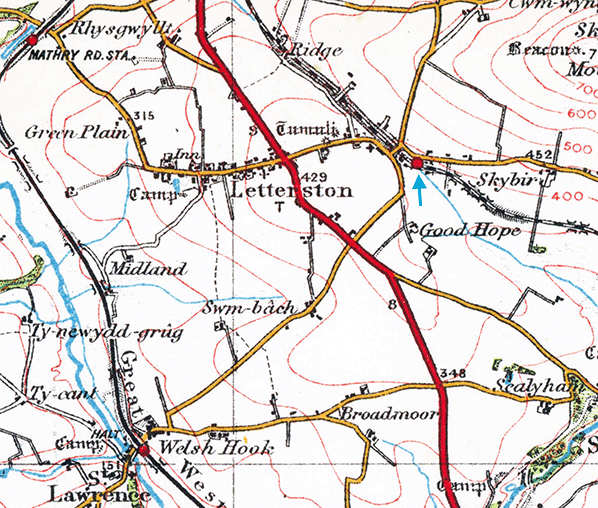 
1907 1:2,500 OS map shows the layout of Letterston station after the opening of the extension to Fishguard. The original platform is on the north side of the line. The station building is seen with a small canopy over the platform. The building to its left is the stationmaster's house; the signal box (SB) is at the other end of the platform. The down platform has a waiting shelter opposite the station building. The GWR engine shed is seen opposite the signal box; the two sidings running past the shed probably served the 2-road carriage shed that was moved to Whitland in 1901. There is a large goods yard with four sidings, one of which passes through a goods shed. The siding opposite the goods shed was probably for livestock. Click here for a larger version.
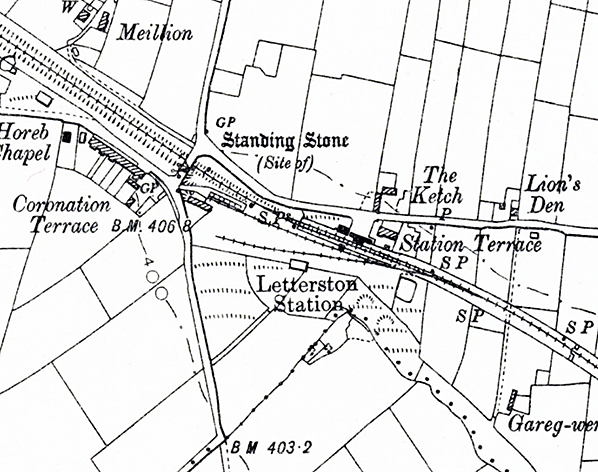
1953 1:10,560 OS map. The layout of the goods yard has been simplified with only two sidings now remaining. The engine shed has gone as has the goods shed. For some reason the WW2 concrete huts are not shown.
old5.jpg)
Whitland locomotive shed seen here in a somewhat dilapidated form in 1921. The building had been a 2-road carriage shed at Letterston until 1901 when it was dismantled, taken to Whitland and re-erected as a single-road locomotive shed. The dilapidation, piles of clutter and the locomotive bufferbeam on an accommodation trolley paints a scene reminiscent of a Colonel Stephens railway. To the left stands an 0-6-0PT while beyond the shed stands what appears to be one or other of the 2-6-2T types and, to its right, a water column. In the right distance another locomotive faces towards the camera with, to its right, Whitland's water tower. The shed area is provided with adequate light by the provision of incandescent mantle gas lighting.
Photo from Roger Griffiths collection old4.jpg) This view of Whitland locomotive shed shows the opposite end to that seen in the 1921 view. This view was thought to date from circa 1904 but is actually somewhat later. The locomotive on the right is difficult to identify and is probably one or other of the 2-6-2T types. That in the shed, peeping out at the turntable, is one of the relatively little-known and somewhat ungainly 3901 class 2-6-2Ts. The class comprised 20 examples which were rebuilds of Dean Goods 0-6-0s. The rebuilding, which took place between 1907 and 1910, was a cheap answer to the need for a more powerful tank type for Birmingham area suburban traffic. A Swindon Works drawing of the 3901 class has survived and it would appear little more than the running gear of the Dean Goods donors was reused. From 1923 the 3901 class began to drift away from the Birmingham area, with many ending up in South Wales and the West of England but cannot have been particularly useful as the class became extinct by the end of 1934. At the time of writing details of Whitland's turntable remained elusive. Whitland shed closed to steam in September 1963 and finally in January 1966, by which time its allocation was just a handful of diesel shunters of the type which became Class 03.
Photo from Roger Griffiths collection old2.jpg)
Letterston station looking towards Letterston Junction sometime in British Railways days. The station was located about one mile from the village centre and today it is ironic that postwar development has seen the village stretch eastwards to the site of the former station. Letterston signal box had stood on the up platform but had been abolished as early as 1926. Wartime reinstatement of the loop, presumably the track on the left, saw ground frames installed in connection with excursion trains for troops encamped in the area. One would assume that this was for relatives to visit troops rather than the other way around. RNAD Trecwn was nearby but served by its own spur which branched off between Letterston Junction and Letterston station. The goods yard, left, maintained a healthy amount of business when photographed and there was a facility for handling tank wagons. The crane looks suspiciously like a standard GWR 6-ton example although records up to 1956 maintain it was of 30cwt (1-ton 10-cwt or 1½ imperial tons)
Photo from John Mann collection old3.jpg)
A general view of Letterston station and good yard in British Railways days and looking towards Puncheston. The photograph was taken from the bridge which can just be seen in the background of the view looking along the platform and probably taken at the same time. The road on the left goes to Little Newcastle and Puncheston. The house behind the station, on Station Terrace, still stands and is still recognisable today. The sheds on the right, erected during WWII and standing on staddle stones (stilts to raise the buildings from the ground, an anti rodent measure) also still stand but the rest of this scene is little more than an open tract of grassland. No trace of the bridge remains today. The two-bay building on the platform was in later years known as 'Station Bungalow' and is assumed to be the stationmaster's house. The house behind it is one end of Station Terrace.
Photo from John Mann collection 1.jpg) Letterston station looking south-east towards Puncheston in July 1974, ten years after the station closed to all traffic. The station building has been demolished but the adjacent house survives in private occupation.
Letterston station looking south-east towards Puncheston in July 1974, ten years after the station closed to all traffic. The station building has been demolished but the adjacent house survives in private occupation.Photo by John Mann Click here for Letterston Station Gallery 2:
|
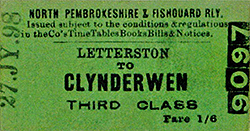 Notes: Letterston was the largest station on the North Pembrokeshire & Fishguard Railway and when it opened on 11 April 1895 it was the terminus of the line from Clynderwen. At that time it possessed only one 250ft platform on the up side of the line. The station building was single storey and of timber construction with a pitched slate roof and an upward sloping canopy over the platform. Adjacent to this was a single-storey ‘L’ shaped stationmaster’s house with a hipped slate roof. The goods yard was opposite the platform and included six sidings and a goods shed. The yard catered for a full range of goods traffic and had a 1-ton 10-cwt crane. In later years it no longer handled livestock.
Notes: Letterston was the largest station on the North Pembrokeshire & Fishguard Railway and when it opened on 11 April 1895 it was the terminus of the line from Clynderwen. At that time it possessed only one 250ft platform on the up side of the line. The station building was single storey and of timber construction with a pitched slate roof and an upward sloping canopy over the platform. Adjacent to this was a single-storey ‘L’ shaped stationmaster’s house with a hipped slate roof. The goods yard was opposite the platform and included six sidings and a goods shed. The yard catered for a full range of goods traffic and had a 1-ton 10-cwt crane. In later years it no longer handled livestock. 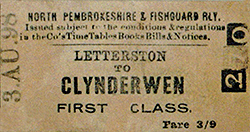 Letterston was the headquarters of the company and Alan Nichols was appointed General Manager of the line prior to the opening. He had an office at the station which was originally intended to be a refreshment room but a licence for this had been refused by local magistrates. A licence was eventually granted in August 1897 with separate bars being provided for 1st and 3rd class passengers. It is not known where Alan Nichols moved to when his office was required for its intended purpose.
Letterston was the headquarters of the company and Alan Nichols was appointed General Manager of the line prior to the opening. He had an office at the station which was originally intended to be a refreshment room but a licence for this had been refused by local magistrates. A licence was eventually granted in August 1897 with separate bars being provided for 1st and 3rd class passengers. It is not known where Alan Nichols moved to when his office was required for its intended purpose.
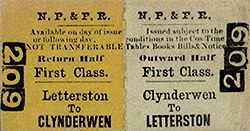 The 2-road carriage shed was dismantled by the GWR in 1901 and re-erected at Whitland as a 1-road shed, in replacement of an original Pembroke & Tenby Railway shed of 1863 which had burned down. The former Letterston building actually came into use in 1902, but by 1938 was in a parlous state so the GWR remodelled it using the original framework with new corrugated cladding and the roof changed from a ‘Dutch Barn’ type to a single gable. It finally closed 9 September 1963. The GWR engine shed at Letterston closed in 1906.
The 2-road carriage shed was dismantled by the GWR in 1901 and re-erected at Whitland as a 1-road shed, in replacement of an original Pembroke & Tenby Railway shed of 1863 which had burned down. The former Letterston building actually came into use in 1902, but by 1938 was in a parlous state so the GWR remodelled it using the original framework with new corrugated cladding and the roof changed from a ‘Dutch Barn’ type to a single gable. It finally closed 9 September 1963. The GWR engine shed at Letterston closed in 1906.
 On 15 September 1926 services on the branch were retimed so that trains did not cross at Letterston. At this time the signal box was closed and a ground frame was installed.
On 15 September 1926 services on the branch were retimed so that trains did not cross at Letterston. At this time the signal box was closed and a ground frame was installed.  After closure of the North Pembrokeshire branch to all traffic between Letterston and Clynderwen on 16 May 1949 Letterston remained open for goods traffic, coming under the control of Mathry Road. Many traders preferred Letterston as it had better siding accommodation. The station finally closed to all traffic on 1 March 1965 although a private siding remained in use after that date. The Letterston station site is now owned by a company called Pembrokeshire Industrial Units. The WW2 storage buildings are all still standing and are now in industrial use. Part of the station building survived in private occupation until the death of the occupant. The building was demolished in 2007 and a house (now three houses) was built on the site. The landowner is currently building new industrial units on the north boundary and he is also working with Pembrokeshire County Council to get a public footpath through the yard to follow the route of the railway line.
After closure of the North Pembrokeshire branch to all traffic between Letterston and Clynderwen on 16 May 1949 Letterston remained open for goods traffic, coming under the control of Mathry Road. Many traders preferred Letterston as it had better siding accommodation. The station finally closed to all traffic on 1 March 1965 although a private siding remained in use after that date. The Letterston station site is now owned by a company called Pembrokeshire Industrial Units. The WW2 storage buildings are all still standing and are now in industrial use. Part of the station building survived in private occupation until the death of the occupant. The building was demolished in 2007 and a house (now three houses) was built on the site. The landowner is currently building new industrial units on the north boundary and he is also working with Pembrokeshire County Council to get a public footpath through the yard to follow the route of the railway line.
 Home Page
Home Page